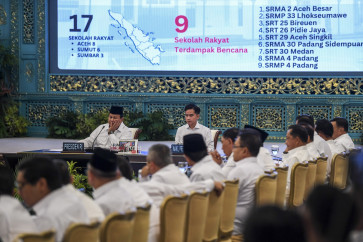Popular Reads
Top Results
Can't find what you're looking for?
View all search resultsPopular Reads
Top Results
Can't find what you're looking for?
View all search resultsEnvisioning the banking technology landscape of 2025
It is highly likely that the 2025 national banking landscape will adopt a pro-technology and pro-market stance.
Change text size
Gift Premium Articles
to Anyone
T
he claim that “banking is necessary, banks are not” is an idea that must not become reality. This statement was asserted by Mirza Adityaswara five years ago during his tenure as senior deputy governor of Bank Indonesia (BI), he now serves as vice chairman of the board of commissioners of the Financial Services Authority (OJK). That reflective warning seems to resonate even more profoundly as we enter the new year of 2025, mirroring the evolving landscape of the national banking sector.
The Indonesian Banking Surveillance Report (LSPI) for the second quarter of 2024 reveals that the growth of commercial bank branch networks remains below market expectations, while the expansion rate of rural bank (BPR) networks has suffered a decline, entering the red zone. In contrast, third-party funds (DPK) remain relatively stable in the green zone. This statistical picture underscores the declining relevance of traditional banking institutions, through physical branch networks, in meeting market needs.
At this juncture, digitalization in banking has ceased to be merely a complementary element; instead, it has become an almost perfect substitute for banking service users. In response to this situation, one critical question arises: “Has the trend of banking digitalization provided a solid answer to market needs?”
The United Nations Conference on Trade and Development (UNCTAD), in its “Digital Economy Report 2024,” highlights that global economic growth is significantly driven by digitalization trends, including in the banking sector. This perspective aligns with the remarks of BI Governor Perry Warjiyo during the 2024 BI Annual Meeting (PTBI) on Nov. 29. He emphasized that the core focus of BI's 2025 policy mix strategy will be strengthening financial sector digitalization through enhanced digital payment systems.
This vision seems to restore banks to their fundamental role as intermediaries in financial transactions. However, it also delivers a significant blow to BPR and Islamic rural banks (BPRS). According to the Deposit Insurance Corporation (LPS), nearly 20 BPR were predicted to exit the national banking competition by the end of 2024. This raises serious concerns, as macro-oriented policies often become an unforgiving mirror for smaller players like BPR and BPRS, despite their strategic contributions to enhancing national financial inclusion. Therefore, the persistent challenge lies in ensuring that the status quo of digitalization trends among BPR and BPRS evolves to keep them relevant in the marketplace.
Looking further into BI's integrated financial inclusion experiment through its 2025 Payment System Blueprint (BSPI 2030), two keywords emerge as the driving force: innovation and technology. These priorities underscore that the modernization of banking services is no longer about complementing traditional banking models but about fully substituting them with digital capabilities. One of the key highlights of this transformation is the development of the digital rupiah, strengthened by the launch of the Proof of Concept (PoC) Wholesale Digital Rupiah Cash Ledger. This initiative marks an early-stage trial of the Central Bank Digital Currency (CBDC), aimed at mitigating the growing influence of cryptocurrencies as alternative currencies.
In parallel with BI's measures, the OJK has been officially mandated as the new regulatory body overseeing cryptocurrency assets through Law No. 4/2023 on financial sector development and strengthening. However, the key question remains whether the banking landscape will maintain a conservative stance toward cryptocurrencies and other digital innovations, even as the OJK formally acknowledges financial technology innovation (ITSK) in its regulations.


















